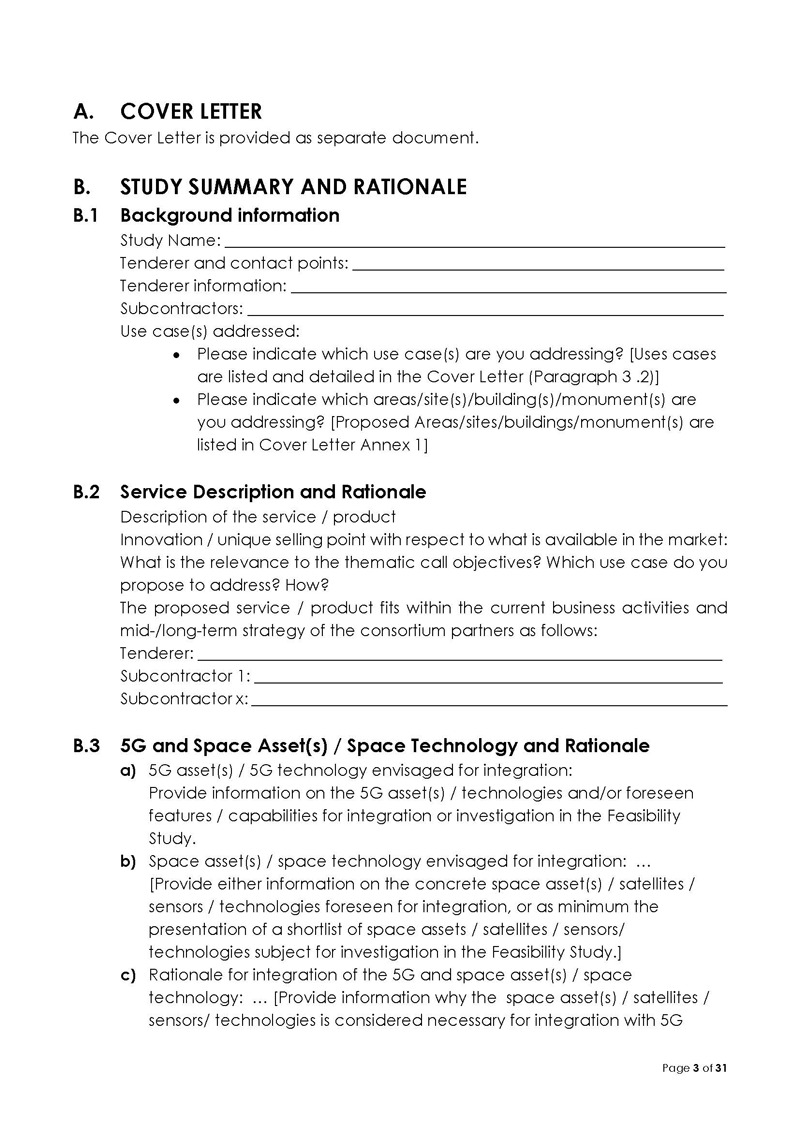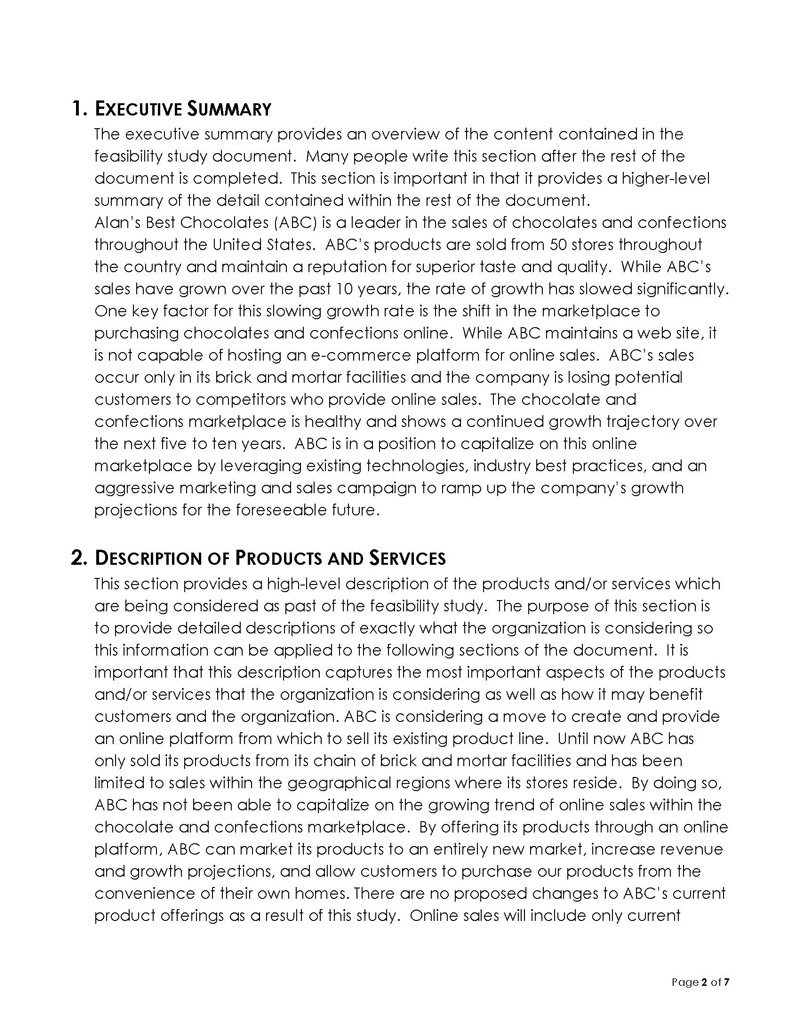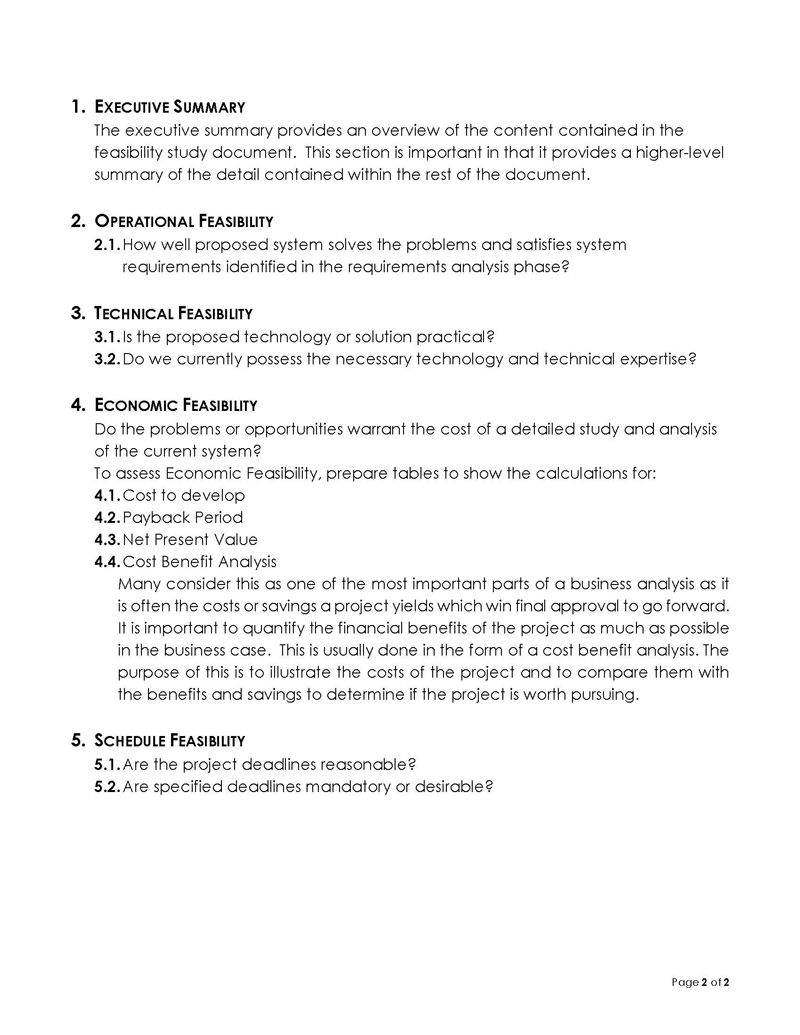A feasibility study, also known as a feasibility analysis, is a project management technique that will protect your company from any problems during the execution of a new project.
Such study is a crucial stage in project management because it determines whether a project (depending on the sector and objective of the company) is feasible, doable, and worthwhile to be pursued. Some of its characteristics are:
- A feasibility study involves an in-depth analysis of the potential for success, looking at factors such as technical feasibility, human resources, facility and equipment, finance and budgeting, economic feasibility, political feasibility, legal and contractual aspects, and marketability.
- This study is also called feasibility analysis or risk assessment.
- A project’s success or failure may depend on how well its feasibility study is done.
- This study is not only done to forecast, measure, or improve financial gains; it could also identify new opportunities through the investigative process.
Free Templates



When to Do It
A feasibility study can be conducted:
- After the business case (a business case explains why a project, idea, or task should be started).
- At the early stage, right before the business plan of any project. Decision-makers can avoid wasting time and resources on a failed project.
- When deciding on launching a new business or adopting a new product line.
Why Do You Need It?
You need to conduct a feasibility study for the following reasons:
- You need it to know the viability of your new project.
- You need it to define the goals and objectives of the project.
- You need it to develop a plan.
- You need it to determine the right resources needed to execute that plan.
- You need it to determine the factors that will make the project plan a success.
Benefits
Completing a feasibility study can give you the following benefits:
- It can provide a company with information that will stop a company from pursuing a risky business venture or partnership.
- It can be useful to know whether the benefits outweigh the drawbacks or vice versa.
- It provides a clear roadmap for moving forward.
- It could be used to find investors.
- It can call attention to new ideas, opportunities, or alternatives that were not obvious.
- It can help you to assess the market potential for your product or service, identify your target customers, and determine the best way to reach them.
- It can also help you to assess the financial viability of your business.
- It can help develop a marketing plan and create a realistic budget.
- It can help project managers maintain focus and improve the delegation of duties.
- It helps to prepare for contingencies in case of unenforceable events or failure of plan A.
Five Questions a Feasibility Study Must Answer
Even though there are numerous variables to take into account when determining whether your project, plan, or methodology is feasible, starting with these five fundamental questions is a good idea. You can improve your chances of success and prevent future costly mistakes by carefully reviewing each of these areas.
Here are examples of each of them:
Is this plan technically feasible?
This question implies that it’s crucial to make a list of the technical resources your organization has available as you start to plan a new project. This includes both hardware and software, as well as any other assets that might be relevant to the project. You can more accurately assess whether your company has the resources required to complete the project by understanding the capabilities of your current infrastructure.
In some circumstances, it might be necessary to find extra funding to handle the demands of the new project. This could mean ensuring there is enough bandwidth on network connections, checking out database size against tasks requiring storage space, etc.
Is this plan legal?
Every project manager must understand that one of the most important things to do before beginning a project is to ensure that the plan is legally sound. A plethora of laws and regulations may apply to any given project, and it is critical to ensure that all relevant requirements are met. Save yourself time, stress, and resources by doing your due diligence upfront. This includes everything from data protection laws to building regulations.
Is this plan operationally feasible?
This is a critical part of the planning process. You must be confident that the project will solve the problems you expect it to solve, and that the solution will be reliable, maintainable, and affordable. A project that is not operationally feasible will almost certainly result in a waste of time and resources.
Is this plan feasible within a reasonable period of time?
This is one of the most important questions related to any project. When starting any new project, it is important to ask yourself if it is feasible within a reasonable period of time. Can you complete the project without sacrificing quality or missing deadlines? If not, you might have to adjust your schedule or reduce the size of your project. Establishing a realistic schedule from the outset is essential to ensuring a successful outcome. Otherwise, you risk missing deadlines and compromising the quality of your work.
Is this plan economically feasible?
This is a question about whether or not the project cost can provide the promised value. When evaluating the economic feasibility of a project, there are key factors to consider. First, you need to look at the projected profitability of the venture. Will it generate enough revenue to cover the costs of production while still leaving you with a healthy profit margin? Second, you need to look at the completion cost. Can you realistically finish the project within your budget?
Finally, you must determine how the project will be funded. If you rely heavily on outside investors, you must ensure that they agree with your plans and have faith in your ability to complete the project. These factors will assist you in determining whether or not a project is economically feasible.
8 Steps To Do a Feasibility Study
The following steps must be taken in order to conduct an accurate feasibility study:
Step 1: Conduct the preliminary analysis
Starting a new project can be an exciting but daunting task. There are so many unknowns and factors to consider that it can be hard to even know where to begin. That is why it is critical to conduct a preliminary analysis before embarking on a full-fledged feasibility study.
This preliminary analysis will assist you in the following areas:
- Assess the market space through market analysis. Learn about the opportunities, challenges, successes, and failures that others have encountered while attempting to complete a similar project.
- Understand your competitive advantage. You need to research your competitors to understand their weaknesses and determine what you must do differently in terms of both material and human resources.
- Determine the risks of the project. This means identifying and assessing any risks that could potentially jeopardise the project.
- Creating an outline, which will itemise the milestones to be attained during the project while also detailing the importance of the entire project to the project management team and your organisation as a whole.
Although a preliminary analysis does not completely determine that the project is viable—in fact, you will make new findings during the major feasibility study—a preliminary analysis can guarantee that the project is reasonable and can be undertaken.
Step 2: Outline your project scope
Now that you understand the basics of the project you are undertaking, it is time to create a scope outline. This outline will detail the project’s objectives by answering five feasibility questions about technical feasibility, legal feasibility, operational feasibility, timelines, and economic feasibility. The answers to these feasibility questions will help develop a clear picture of the project, including what needs to be accomplished and how you plan to do it.
Furthermore, this outline will assist you in identifying any potential flaws in your plan so that you can address them before beginning implementation.
Step 3: Perform a market analysis
Market analysis will give you insight into how well your product or service will be received by potential customers, which will also inform any expectations you may have concerning the project’s profitability. Throughout this process, you will be able to identify any trends (geographic or demographic) as well as competitor behaviour that may have an impact on your project.
In addition, a market analysis will consider the value of the project and what the project manager’s share will be if there is market expansion, depending on the project manager’s demand.
The benefits of market analysis include the following:
- Aids in the discovery of market opportunities (such as potential customers who can be targeted) for your project.
- Helps to know your competitors and their practices. This includes their customer base, marketing techniques, product or service distribution, etc.
- It assists in determining the market demand for your product or service in terms of needs and size.
- Helps to know and understand the trend of similar projects in the past, the cost, and the successes achieved.
- Helps to discern the best approach (such as execution date and necessary personnel) that can be used to achieve the project.
The following methods can be used to conduct market analysis:
- Surveys
- Personal interviews (customers, outside investors, experts
- Focus group
- Social media listening
- Research other organisations
- Public domain data
For more reliable market research, endeavour to get both subjective data (from methods such as personal interviews and focus groups) and objective data (from methods such as social media listening and public domain data).
important note
Regardless of which of the examples above or other similar methods you use, make sure that your market analysis/market research answers the standard five feasibility questions.
Step 4: Calculate the financial cost
When starting a new project, one of the most important things to do is calculate the project’s expected financial cost. The feasibility of a project proposal greatly depends on various financial factors. Begin by considering the services that will be required and how much they will cost. Then, consider any adjustments that need to be made to revenues, such as reimbursements.
Below are tips and considerations that can help you during financial estimates:
- Will your project be self-funded, or will your organisation be getting funding from an outside source (for example, an angel investor)?
- If any failure occurs during the project, what will be the financial risk?
- Which risk is most likely to put a financial strain on the project’s budget?
- Is there a break-even point set for the project, and at what exactly is it (i.e., the point at which total cost and total revenue are equal)?
- What is the total cost required to execute the project (including risks and miscellaneous)?
Always keep in mind that you may spend more than you planned, especially considering the financial cost of potential issues.
Step 5: Set up the organisation and operations
The goal of organisational and operational feasibility is to ensure that the project can be completed in a practical manner. In this step, the specifics of the project’s daily administration and management are elaborated upon. In addition, start-up costs, fixed investments, and operating costs, as well as any technical, legal, and economic feasibility factors, must be considered.
Step 6: Create an opening day balance sheet
You will need to consider all of the assets and liabilities that will be involved in your project. This includes items such as land, buildings, and equipment, as well as financing for accounts receivable. In order to create a realistic balance sheet, you must also accurately estimate the costs of these items. Once you have all of this information, you can determine whether your project is financially feasible. If you rely on external financing, you must factor in the loan’s interest rates and terms. This can be a complex process. However, it will produce a balance sheet that fairly depicts the project’s financial situation.
tip
While thinking about the potential upside of success, do not forget to consider the potential downside of failure. What happens if the project fails? How will that affect your organisation’s finances? This gives you a better insight into the financial risk and helps you determine if the project is worth it or not.
Step 7: Review, analyse, and present your research
Conduct a review of your research and data and present it to the decision-makers. Your findings must answer all five feasibility questions already discussed above before moving ahead with the project. Even if there are some possible issues, they might not be catastrophic. Instead, it could be an opportunity to reevaluate your budget, approach, or goals.
Step 8: Make the final decision
It is time to make the final decision, and the only thing left is to decide whether or not this project is feasible. Before deciding whether the project is feasible for your organization, consider several factors, such as the commitment of resources required and whether they align with company leadership’s goals and long-term aspirations.
Key Sections of a Feasibility Study
The following are sections that are typically found in such study:
1. Executive summary
The executive summary is an excellent way to convey the key points of your research in a short and concise manner. This must include a narrative that details the entire project, including the purpose, product, and/or service itself, as well as the project plan.
An executive summary is not required, but it can be helpful for those projects that involve lengthy studies or complex concepts.
An executive summary should not exceed one page and must cover a summary of the aspects below:
- The examined issues in the feasibility study
- The objective of the business as supported by the study
- Organisational Impact
- Process impact
- Required cost and benefits
- Projected risks
1.1 Guidelines for writing an executive summary
You should write your executive summary after concluding every other section of your feasibility study. It should cover a summary of all findings made during the study while also composing your text in brief paragraphs that are easy to read and understand by your audience. Be prepared to use about two hours for this process.
Introduction:
The introduction to your feasibility study should give the target audience a general idea of what they can expect from reading further. It includes at least two topics and may further highlight other subtopics.
Specify exactly the intended audience for the document. Then, highlight the purpose and factors that justify the need for a study and other topics that are part of the introduction. Writing this section, including all its sub-sections, will take about 10 hours.
2. Technological considerations
Technological considerations are an essential section of a feasibility study. This section should include information about the technology that would be used at each stage of the project, including preliminary design and detailed engineering plans.
Asking the following questions will provide the information needed concerning technological considerations:
- What will it take to execute the project?
- Do you have what it will take in terms of personnel and costs?
3. Existing marketplace
This will include details about the potential market demand for your goods or service, the existence of any rivals, current market trends, and how the aforementioned factors might affect your company.
4. Justification
The justification section provides a detailed assessment of the motivation behind the feasibility study. There should not be more than three to four paragraphs in the introduction to “the justification section.”
Below are the sub-sections and topics that the justification section must cover:
- Problem statement details the main problem the feasibility study is researching.
- Organisational impact details how the organisation will be affected by the problem identified.
- Business impact details how the problem affects business setup, each unit of the business environment, and personnel.
- Process impact lists businesses affected by the process.
- Solution objectives details on benefits to expect as well as the cost of execution while solving the problem.
4.1. Guidelines to write the justification
Start your introduction to the justification section with simple words and terms. Instead of describing the steps involved in the process, concentrate more on describing its characteristics. Ensure that you get an analysis of all business activities before you begin to write.
5. Personnel requirements
This includes the human capital needs for this project (what staff needs to be hired), their qualifications, and experience. This includes an organisational chart with names listed beneath each position on the chart so that you know who is in charge of each task.
6. Schedule and timeline
This section includes details about the exact date and time frames when specific tasks need to be completed. It also indicates how much time is left until each milestone is reached, and stakeholders and decision-makers can use it to help them decide on the best strategy to complete those tasks.
7. Project financials
This section evaluates the financial viability of your project by outlining projected costs and revenues. It assesses your finances and clarifies your project’s technology, marketing, and organisational needs.
8. Findings and recommendations
This section is perhaps the most important part of the document, as it provides a clear direction for the future. The “findings” part summarises all of the relevant information that has been gathered during the study, while the “recommendations” part provides specific guidance on how to proceed further.
9. Solution
This section describes the proposed solution to the identified problem and how it can improve the state of all organisational units. It will also describe all benefits to be gained, the cost of the process (solution), the proposed solution’s characteristics, and its functionality.
The solution section of most feasibility studies contains topics and sub-topics with a similar context to the justification section. It describes how specifically the proposed solution will transform these areas.
10. Alternatives
This describes the other solutions that have been considered. It then delves into why some solutions were not chosen, usually due to cost or effectiveness, and why others were overlooked despite having the desired effect on the problem.
11. Cost-benefit analysis
The section includes some calculations and indicators that support the proposed solution’s approval. The following values are included in the cost-benefit analysis: Net Present Value (NPV), Return on Investment (ROI), and Payback Period (PP).
These calculations provide further information that describes the future revenues and expenses of the project and indicates if it will be profitable or not. It provides valuable insights into the likely economic impact of a proposed project.
Conclusion
Is a feasibility study worth your investment? In conclusion, if done correctly and thoughtfully, this study can be a valuable exercise for your project. It allows you to test your ideas and assumptions before making a larger commitment, provides valuable insights into the viability of your proposed project or venture, and can increase your chances of long-term success.
A well-conducted feasibility study can help you avoid costly mistakes in the future and give you the information you need to make informed decisions about your project. Therefore, if you are considering starting a new project, we strongly advise conducting a feasibility study first.




